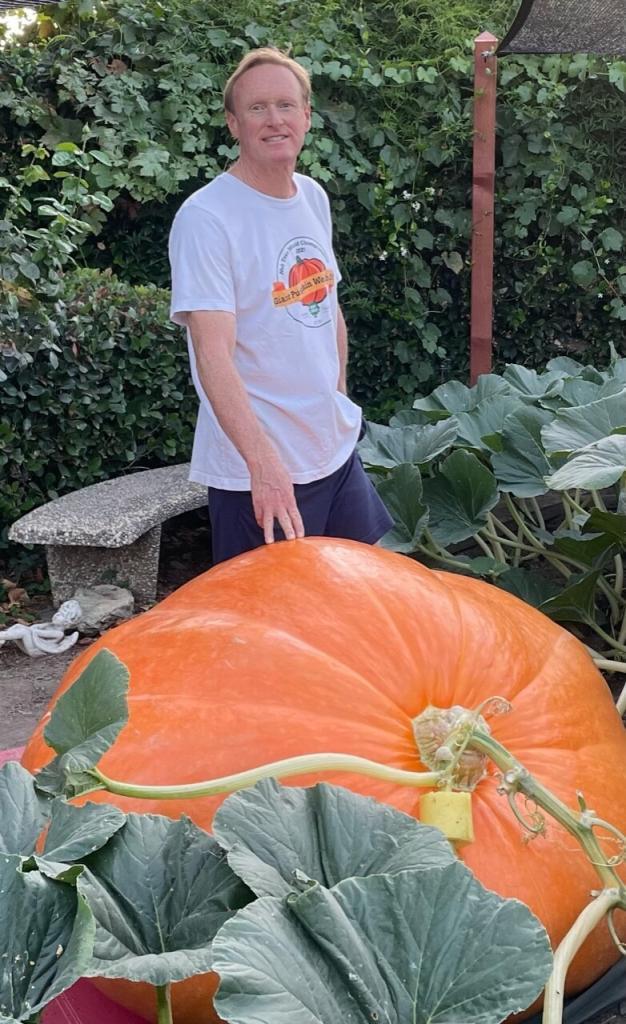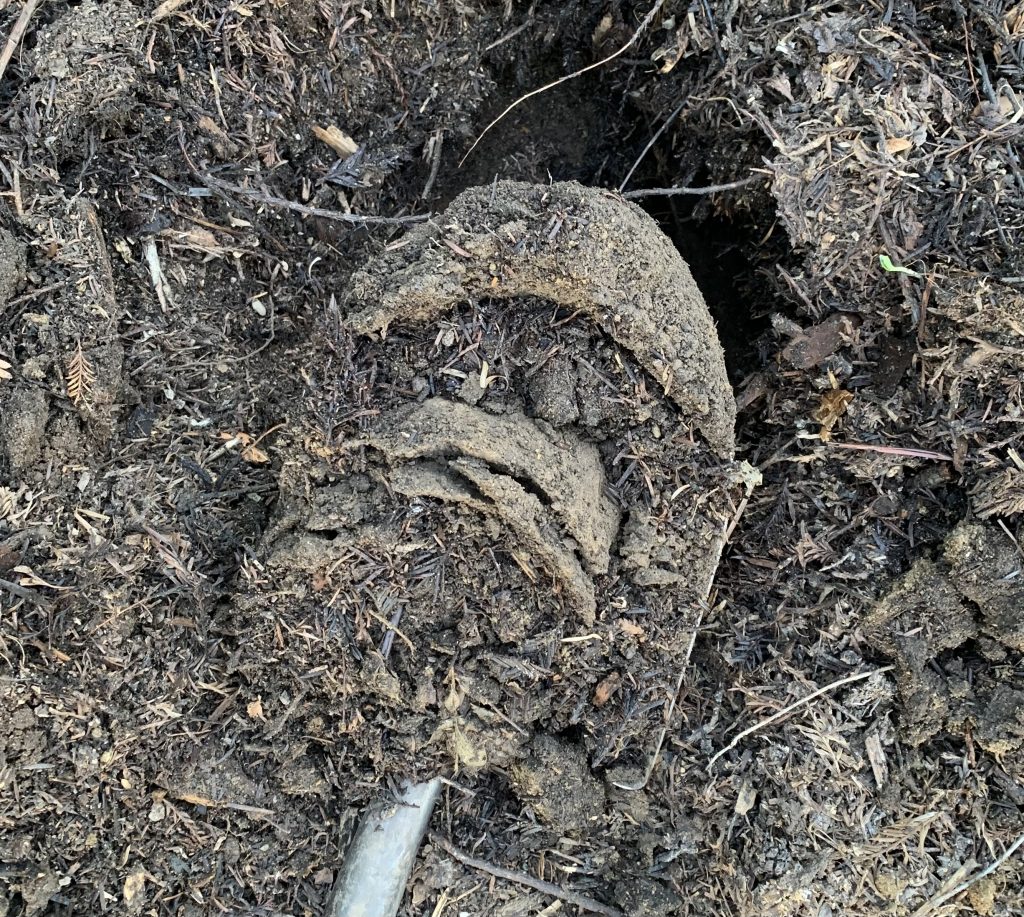Ever wonder how giant pumpkins are grown? By incorporating various growing giant pumpkin tips, such as soil building techniques, water and fertilizing strategies, you can grow a impressive giant pumpkins.
And when that crop grew, and was harvested, no man had crumbled a hot clod in his fingers and let the earth sift past his fingertips. No man had touched the seed, or lusted for the growth. Men ate what they had not raised, had no connection with the bread. The land bore under iron, and under iron gradually died; for it was not loved or hated, it had no prayers or curses. John Steinbeck, the Grapes of Wrath.
John Steinbeck describes what happens when someone else raises your food for you. You become disconnected from your land. You must be connected to your soil and if you are growing giant pumpkins you must be inextricably linked to your soil. Life comes from the soil. Soil is a wonderfully complex matter that deserves attention. You must take care of it.
You inherit certain soil from your backyard, and you can’t change that fact, but you can change your soil for the better. I spend a lot of time amending my soil with healthy things, taking care of it, and preserving it. In order for this to hit home, it must be simple, not overly complicated.
Giant Pumpkins and Soil Basics
The table below shows the major components of soil. Each component is broken down into categories and items (if applicable). My review of soil components is structured in the table below. Soil is composed of four components: approximately 45% inorganic matter, 5% organic matter, 20%-30% water, and 20%-30% air.
Soil components, categories within components and items if applicable. Percentages are approximate.
| COMPONENT | CATEGORY | ITEM | PERCENT |
|---|---|---|---|
| Inorganic matter | Particles and elements | clay, silt, sand nitrogen, phosphorus, potassium, etc. | 45% |
| Organic matter | Plant, animal, microbial | plant residue, detritus, humus gophers, earthworms, insects, etc. fungi, bacteria, archaea, protozoa | 5% |
| Water | 20%-30% | ||
| Air | 20%-30% |
Inorganic matter
Soil is made up of rock, sand, silt, and clay. Of course, there are boulders and large rocks but these are not common in garden soil. Soil is classified by the different sizes of particles, and the proportion of those sizes. The primary particles are sand, silt and clay. Sand particles are classified between 2.00 mm and 0.05 mm. Silt is anything between 0.05 mm and 0.002 mm and clay is less than 0.002 mm. The proportion of these three elements will determine the type of soil you have.
If you have too much of any one you’re gonna have problems, but there is a way to mitigate the inadequacies. You can do some simple tests at home to estimate how much of the different three particles you have. Alternatively, you can send soil samples to labs to test. I routinely test my soil every year to get an idea of how things are looking on my giant pumpkin growing adventure.

Last year my soil was classified as clay loam which in my opinion is very suitable. The ideal soil is approximately 40% sand, 40% silt, and 20% clay. When you have an ideal mixture like this, it is termed “loam”. Loam has efficient water drainage and allows air to enter the soil, yet it also holds moisture well.
When there is too much sand, the spaces between the particles are too large and water flows through too quickly as a result. When this happens, it is difficult to keep your soil hydrated and absorb nutrients. If there is too much clay and not enough sand, for example, the opposite happens. Water will not pass through the soil enough and over-saturate it. Less oxygen is present and thus less microbial life. Consequently, fewer nutrients can be absorbed by the roots in this case.
Other inorganic matter in soil includes macronutrients and micronutrients. These nutrients exist in healthy soil and are used by your plants if available. It can be necessary to augment your soil with macro- and micronutrients to maintain a high intensity growing environment.
The macronutrients you most commonly hear about are nitrogen (N), phosphorus (P), and potassium (K), and they are required for plant growth. These are primary macronutrients. Fertilizer you purchase will come marked as the percentage of each of these key three ingredients.
Nitrogen is essential for growth as it is involved in energy metabolism and protein synthesis. Plants can absorb nitrogen through their roots as nitrate or even on their leaves and stems. A helpful example of what nitrogen will do is when you fertilize your lawn it will green up and grow faster.
Phosphorus supports root growth and energy transport. You need healthy roots to absorb nutrients and phosphorus to develop and grow. Potassium increases photosynthesis capacity, strengthens cell tissue, and helps absorb nitrates.
Secondary macronutrients include calcium, magnesium and sulfur and these too are needed for plant growth, however, not in large quantities like primary macronutrients. Healthy fertile soil will have these nutrients available for root absorption.
These macronutrients can be depleted over time with heavy planting and become less available if your soil is not balanced. While it is easy to find primary macronutrient fertilizers, secondary macronutrient fertilizers are less common.
Some plants are very sensitive to primary macronutrients and absolutely need them for healthy development. For example, calcium deficiencies can cause blossom-end rot in tomatoes and prevent pumpkins from developing. If you notice problems with your vegetables, it could be due to secondary macronutrient problems.
Additional micronutrients include Boron, Zinc, Iron, Manganese, Copper, Molybdenum, and Chlorine. Again, these nutrients are present in your soil and are part of a fertile loam. If you maintain a healthy amount of organic matter, you are likely to be well-stocked with micronutrients.
Organic matter
Detritus is composed of dead plants and animals like fallen leaves, manure, and leaf litter. This term describes all of this valuable stuff found in your soil. Much of the organic matter in soil comes from plant tissue at various stages of decomposition. This decomposed matter is either transformed into usable things such as soil nutrients in the form of humus, or used as food for other organisms.
Plant tissue releases nutrients into the soil in a way that plants can use. Think of a forest floor with decades of leaves and branches built up. Mulch is extremely helpful in building up soil organic matter as you add detritus to soil starved of this substance – because we don’t garden on a forest floor. By providing mulch, you add valuable organic matter to your soil. You can’t see it, but it happens!
Large animals in your soil such as earthworms, moles, gophers, snakes, and insects all play a role in soil health. There are millions of insects that spend their entire lives in the soil. Earthworms, sowbugs, mites, centipedes, millipedes and spiders live in the soil. Soil organisms play a critical role in decomposing organic materials and preparing the soil for plant growth.
These large animals and insects are susceptible to chemicals and care must be taken to minimize chemical spray impacts on them. The organic garden has a huge advantage over the chemical-ridden garden in that the soil is alive and actively converting detritus into usable nutrients.
By far the most fascinating part of soil life is the microbial community. It is said that only one percent of soil microscopic creators have been described and understood. We talk about nematodes, algae, amoebae, actinomycetes, bacteria and fungi.
All these microbes play a valuable role in soil health. Nematodes help by regulating other soil organism populations, converting nutrients into plant-available forms, providing a food source for other soil organisms and consuming other organisms. Algae fix nitrogen (prepare it for plants to absorb) and improve soil fertility by preventing erosion and adding dead matter as nutrients.
Amoebae control bacterial populations, eating them and keeping them in check. Actinomycetes play a major role in the recycling of nutrients in the soil, facilitating the breakdown of organic matter into usable forms of plant nutrients. Bacteria are extremely numerous and help to recycle nutrients as well. In addition, they improve soil structure by forming microaggregates in the soil by binding soil particles together with their secretions.
Amazing Fungi
Have you ever worked in your soil and noticed a white mass that looked stringy? This is a sign of soil fungus. It looks like stringy white strands or fuzzy areas on the soil surface. These strands, called hyphae are made up of long threads of microscopic fungi cells. This is a positive sign. There has been so much information about beneficial soil fungi recently that I almost view my soil as fungi! There are three types of fungi: (1) biological controllers, (2) ecosystem regulators, and (3) species participating in organic matter decomposition and compound transformations.
As far as biological control is concerned, fungi can regulate diseases, pests, and other organisms. Their role as ecosystem regulators establishes soil structure. For gardeners, the last type of fungi plays a crucial role in organic matter decomposition and compound transformation! This third type of fungus benefits plant growth by creating a mutualistic relationship with plant roots. It assists with nutrient availability and cycling.
Mycorrhizal fungi form a symbiotic relationship with plant roots. As the fungi colonize the root system of a plant, increased water and nutrient absorption for the plant. The plant provides carbohydrates. Mycorrhizae also protect against pathogens. Mycorrhizae fungi presence in the soil in sufficient quantities will greatly increase root mass which in turn leads to larger plants and larger yields. Professional vegetable growers, giant pumpkin growers, and hobbyists purchase quantities of mycorrhizal fungi and amend their soil as studies show substantial growth improvements.
My previous warning to the reader was to avoid chemicals in the garden that negatively affect soil organisms. In addition, certain soil nutrients can be negatively affected by soil tilling. For example, fungi can be particularly impacted by tilling, while bacteria can recover from tilling disturbances. When in doubt, leave the tiller out!
For more about understanding soil for growing giant pumpkins, see see my book, Backyard Big: Growing Atlantic Giant Pumpkins in your Backyard on Amazon and Barnes & Noble. Be sure to check out my Atlantic Giant Pumpkin Blog for topics as well.

